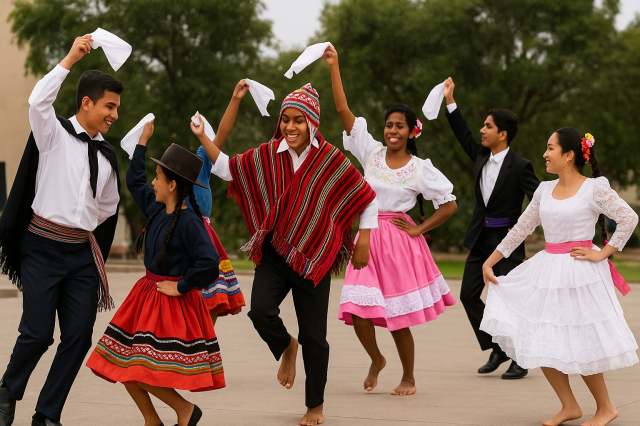When December arrives, schools throughout Peru are filled with color, music, and tradition. End-of-year performances are an opportunity to showcase students' talent and reinforce pride in our cultural roots. Peruvian school dances are not only part of art and education but also a way to strengthen national identity.
Peru is a country of dances, and each region has its own rhythms, costumes, and meanings. Therefore, choosing the right dance for a school performance can be both an educational and cultural experience.
Main school dances by region
Dances of the Peruvian coast
Coastal dances are joyful, festive, and full of movement. Some of the most representative dances for school performances are:
Marinera norteña: a symbol of love and flirtation, ideal for high school students. Its elegance makes it a favorite in school competitions.
Afro-Peruvian celebration: full of energy and rhythm, perfect for large groups of students. It features the use of cajón drums and other percussion instruments.
Tondero: from Piura, it combines grace and mischief. It's excellent for showcasing the coastal spirit.
Alcatraz: fun and participatory, it is usually used in more dynamic presentations.
👉 You can complement this content with our article on the most important Peruvian festivities of the year , where the origin of many dances is explained.
Dances of the Peruvian highlands
Andean dances are known for their colorful costumes, their energy, and their connection to the land and agricultural work. Among the most representative are:
Huaylash: popular in Junín, it represents agricultural work and Andean love. Ideal for group choreography.
Santiago: typical of the center of the country, it is danced in gratitude to Pachamama.
Valicha: from Cusco, cheerful and youthful, perfect for elementary school students.
Cajamarca Carnival: full of humor, color and rhythm; an excellent option to close the school year.
Additionally, you can consult our article on carnivals in Peru to learn about traditional dances that can inspire school presentations.
Dances of the Peruvian jungle
The Peruvian Amazon also has a great cultural wealth that can be brought into the classroom:
Amazonian gang: symbol of joy and unity; it is a collective dance very popular in patron saint festivals.
Anaconda: a dance that represents strength and respect for nature.
Shipibo warrior dance: ideal for representing the identity of native peoples.
These dances promote respect for Amazonian communities and their spiritual connection to the environment. You can find more information at Peruvian Amazonian festivals .
How to choose the best dance for your school
When selecting a dance for the end-of-year performance, it is important to consider some factors:
Age of the students: more complex dances like the marinera or the huaylash can be better suited to secondary school, while simpler ones like Valicha or the Pandilla are ideal for primary school.
Number of participants: some dances require large groups (such as the Cajamarca Carnival), while others are enjoyed in pairs.
Costume availability: each dance has specific costumes; plan ahead to maintain authenticity.
Educational message: prioritize dances that reinforce values such as unity, cultural respect, and Peruvian identity.
Educational benefits of Peruvian dances
Including traditional dances in school activities not only enhances performances but also strengthens cultural education. Among the main benefits are:
Development of national identity.
Teamwork and discipline.
Artistic expression and self-confidence.
Appreciation of the country's cultural diversity.
Furthermore, dances are an excellent tool for applying learning about history, music, and art in an experiential environment.
Program proposal for a school presentation
| Region | Suggested dance | Recommended school level | Main theme |
|---|---|---|---|
| Coast | Marinera, Celebration | Secondary | Love and joy |
| Saw | Huaylash, Valicha, Cajamarca Carnival | Primary and secondary | Andean tradition |
| Jungle | Amazonian gang, Warrior dance | Primary | Amazonian nature and culture |
Where to find music and traditional costumes
Many teachers and parents are looking for resources to help them organize their presentations. Here are some recommendations:
Traditional music: can be found in virtual libraries or educational platforms.
Traditional costumes: available at craft fairs or local shops. Specialized artisans can be found in cities like Cusco, Puno, or Trujillo.
Support from local communities: some folk groups offer workshops for schools.
Promoting cultural pride from the classroom
School performances are much more than just an end-of-year event: they are a celebration of the diversity and talent of Peruvian students. Each dance represents a story, a region, and an emotion.
By integrating Peruvian dances into educational activities, schools become guardians of our traditions and promoters of respect for the different cultures that make up Peru.
